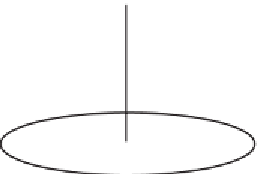Geoscience Reference
In-Depth Information
Figure 2.8
Geometry of incoming ('in') and relected ('out') radiation at a surface.
The combination of four angles deines one point in the bidirectional relectance dis-
tribution function (BRDF).
•
Lambertian relection: This occurs when light falls on a Lambertian surface that relects
radiation equally in all directions (diffuse). Hence direct radiation is converted to diffuse
radiation.
General diffuse relection: Light is relected diffusely, but not equally in all directions.
•
The total amount of relected radiation may also depend on the azimuthal direction of the
incident radiation. Most natural surfaces fall in this last category.
These three types of relection can be applied to the surface of individual materials
(e.g., leaf tissue or water) or to entire surfaces (e.g., a forest or a lake).
One of the few natural
materials
that exhibits specular relection is water. Other
relatively smooth materials may exhibit specular relection to some extent, especially
at small incidence angles (e.g., ice and leaves). Rougher materials (e.g., lat soil and
snow surfaces) usually show some form of general diffuse relection.
When it comes to natural
surfaces
, smooth water surfaces (windless conditions)
exhibit specular relection and observations (see
Table 2.1
) show the related strong
dependence of relectivity on solar zenith angle. When waves are formed on the water
surface, the specular character of the relection is - partly - lost. More generally: for
most types of surface cover not only the material of which the surface consists mat-
ters, but the structure of the surface matters as well (e.g., vegetation, urban areas, soil
with micro relief). Three effects may result in a dependence of the relectivity on the
zenith angle of the incident radiation (see
Figure 2.9
for an illustration using a sim-
pliied structured surface consisting of rectangular objects, for simplicity referred to
as “canopy”):
•
Radiation that hits the objects will be partly absorbed and partly relected. The
relected parts can be directed out of the canopy (thus being counted as relected radi-
ation) or into the canopy. The latter radiation will hit other parts of the canopy and
will in turn be partly absorbed and partly relected (multiple relection will occur).
At small zenith angles (
Figure 2.9a
), the direct radiation will penetrate deep into
the canopy, so that multiple relection and the loss of radiation due to absorption
occur over a large part of the canopy depth. Only a small part of the radiation that





















Search WWH ::

Custom Search